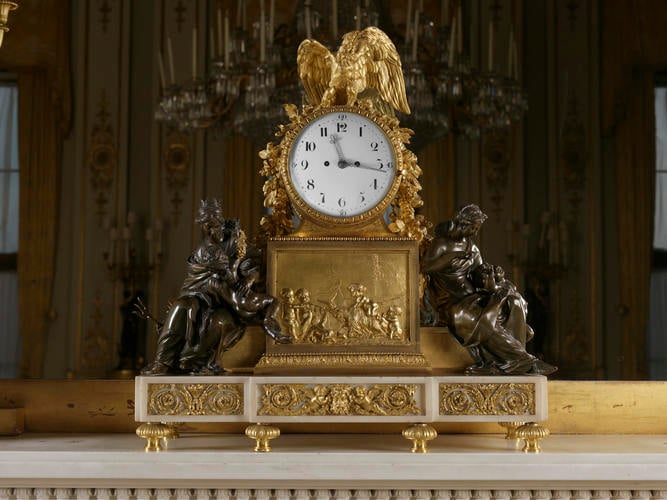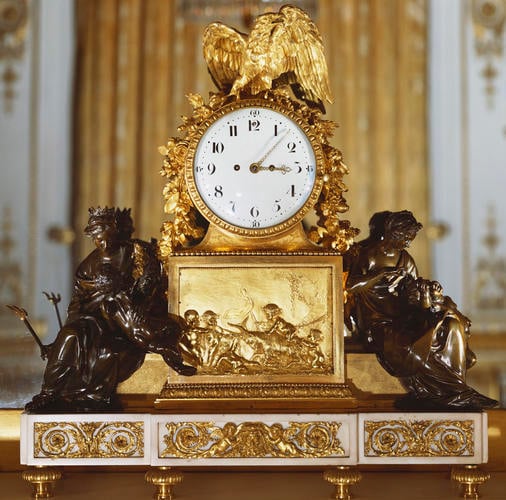Mantel clock second half eighteenth century
Marble, gilded and patinated bronze | 76 x 75 x 32 cm (whole object) | RCIN 2743
-
Gilt and patinated bronze mantel clock in the form of a cylinder crowned by an eagle straddling garlands of fruit and flowers. Raised on a rectangular block chased on the front with bacchic putti playing with a goat. Flanking the block are two sculptural groups both of a classically draped woman with a putto. The whole on a Carrara marble break fronted base decorated with arabesques of gilt bronze, all on six peg top feet.
The original French movement by Jean Antoine Lépine was replaced by Benjamin Lewis Villiamy in 1819. Now the eight day rack striking mechanism has a fusee movement and a ½ dead beat escapement. The enamel dial has the hours and quarters in arabic numers and a pair of pierced gilt hands. Vulliamy number 679. Pictoral Inventory 934746.
Lépine had began his horological career in Geneva. In c.1744 he was apprenticed in Paris to André Caron (1697-1775), the King's clockmaker. He married Caron's daughter in 1756 and was also made a partner in his father-in-law's business. He was received as a maître in 1762 and at the same time he was appointed to the coveted position of Horloger du Roi (Louix XV) et du Garde-Meuble de la Coronne. Until 1772 he operated from premises in the rue Saint-Denis and then transferred his business several times until 1789 when it moved to 12 Place des Victoires. By this time the running of the business was in the hands of his son-in-law, Claude-Pierre Raguet-Lépine (1753-1810), who had joined Lépine in 1783. Joseph Coteau who was known as a leading enamellist and creator of the finest French clocks - intricate enamel work and detail were a characteristic feature of his work; he is responsible for the moon phases and signs of the zodiac on this clock.Provenance
Acquired by George IV before 1814. Originally in the Ante Chamber to the Throne Room at Carlton House.
Included in the Pictorial Inventory of 1827-33 – RCIN 934746. The inventory was originally created as a record of the clocks, vases, candelabra and other miscellaneous items from Carlton House, as well as selected items from the stores at Buckingham House, the Royal Pavilion, Brighton, Hampton Court and Kensington Palace for consideration in the refurbishment of Windsor Castle.
-
Creator(s)
(clockmaker (original movement))(clockmaker (movement))(nationality)(nationality)Acquirer(s)
-
Medium and techniques
Marble, gilded and patinated bronze
Measurements
76 x 75 x 32 cm (whole object)
Object type(s)









